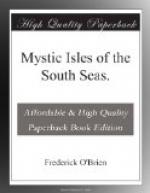Whence had come these Polynesians or Maoris who peopled the ocean islands from Hawaii to New Zealand, and from Easter Island to the eastern Fijis? A race set apart by its isolation for thousands of years from all the rest of the world, distinguished in all its habitats— Hawaii, Samoa, the Marquesas, Tonga, the Paumotus, and the Society archipelago, and New Zealand—by beauty of form, tint and uniformity of color, height, and soft expression—an expression they vainly sought to make terrible by tattooing?
The legends and chants of the race unfolded much of the mystery; its language’s relation to others, more. These Tahitians and all their kind were ancient Aryans who in the dim past were in India, and afterward in the Indian archipelago. They were in Sumatra, in Java, in the Philippines long before the Malays. Certainly their blood brothers, changed by millenniums of a different environment, remain in Malaysia, known there as the aborigines (Orang-Benoa), by the majority races. D’Urville said the Harfouras of Celebes were identical physically with the Polynesians. At some unfixed date the first of the Polynesians pushed out in their insecure craft for this sea, driven away by the Malay-Hindu invasion or by interracial feuds.
The pioneer, according to the legend, was Hawaii-uli-kai-oo, Hawaii and the Dotted Sea, a great fisherman and navigator. He sailed toward the Pleiades from his unknown home in the far West, and arrived at eastern islands. So pleased was he with them, that he returned to his western birthplace for his family, and brought them to Polynesia.
Other Polynesians left the Asiatic archipelago about the end of the first century, and went to many islands. Finally they reached the Samoan, Tongan, Marquesan, Paumotuan, and Society groups, and Easter Island and New Zealand. In pushing eastward they skirted Papua, but were unable to stay, because the Papuans, whom the Polynesians had long ago driven out of the Asiatic archipelago, were stronger than the emigrants. They next tried Fiji, and tarried there longest, leaving those powerful imprints on the Papuans in appearance and language that make Fiji the anomaly of Melanesia. But the Fiji-Papuans at last drove them out, and they left with blood in their eyes. When the whites found the Marquesans in the sixteenth century, they were building at Vaitahu great war-canoes to “attack the black people who used bows and arrows.” No living Marquesan had ever seen them nor could they have attained Fiji in any strength, yet the historical hate persisted.
The Marquesans of the north said their race came from Hawaii, and those of the south from Vavao. Seventeen places they had stopped at in their great migration eastward, they said.
Pu te metani me Vevau
A anu te tai o Hawa-ii!
Pu atu te metani me Hawa-ii
A anu te ao e Vevau!
Blow winds from Vavao
And cool the sea of Hawaii!
Blow back, winds from Hawaii,
And cool the air of Vavao!




